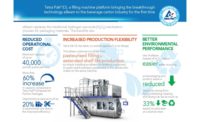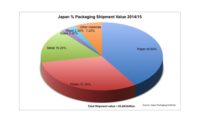As readers of FP know, flexible packaging is a dynamic, exciting field. Innovations continue at dizzying speeds, producing degrees of productivity, cost savings and visual presence not previously achieved. Though much of this innovation comes from improved enhancements to existing flexo press processes, advancements in other technologies are also taking a hand in setting new standards for packaging excellence.
In recent years, electron beam (EB) technology has enjoyed a newfound interest across the world of flexible packaging. An alternative to thermal (oven) drying or ultraviolet (UV) curing, EB’s advantages are best known in web offset printing. Use of EB (or UV) to cure inks and coatings on flexible packaging has historically been an arm’s length choice for flexible packaging producers, since flexo presses usually operate with water- or solvent-based inks.
As the world’s leading manufacturer of EB systems, PCT Engineered Systems has seen strong indications that EB’s presence in the flexible packaging arena will continue to grow. Web offset press production continues to gain favor in the industry, and new, innovative flexo inks are steadily emerging in the market. Printers with solvent-based operations seek production methods that reduce (or eliminate) VOCs (EB curing produces virtually zero emission).
Similarly, on presses where UV curing is applied, food manufacturers are actively seeking ways to reduce (or completely eliminate) the potential for photoinitiator migration. Food manufacturers are also demanding that their packaging retain a variety of rugged characteristics, many which are generated during EB curing.
Options for Visual Enhancements
In addition to is package curing abilities, recent developments have unleashed EB’s astounding package surface decoration potential.
It is this final point that is capturing the imagination of today’s package producers, because it holds such strong potential for differentiating products from a consumer perspective. EB has been generating a lot of interest among food manufacturers and food package converters, not just to improve package quality and reduce manufacturing costs, but also to add a visual pop to their packaging that draws customers to their products.
The visual enhancements offered by an EB package decorating system come in four interchangeable modes of operation: Overprint Coating, Laminating, Cold Foil Transfer and Cast & Cure Holographic Embossing.
EB technology enables the instant curing of coatings and adhesion of laminates to a packaging surface, providing a high gloss and inherent durability that is not possible with other curing technologies. Package producers utilize this increased package strength and sheen to both draw attention to their products and reduce package abrasion and breakage.
With cold foil transfer, an EB-curable adhesive is applied to a substrate at designated spots or in a pattern and then run through an EB cure along with a metalized foil. The foil adheres to the targeted spots and produces a strong visual metalized effect.
Cast and Cure is a decorative coating process that integrates casting and curing. It offers consistent high quality finish, ultra high gloss, matte and holographic images on a variety of substrates, and can provide anti-counterfeiting features. This environmentally friendly process is VOC-free and helps make packages more recyclable by eliminating the laminated, metalized films used in traditional holographic processes. Additionally, this casting film is reused multiple times, achieving substantial cost savings
Advantages with Decorating Systems
EB package decorating systems are designed for use with web printed packaging materials, including flexible packaging, labels and multi-wall bags. Advantages include precise substrate/film handling, high speed, low operating costs, a solvent-free (generating no VOCs) process, and food friendliness. These systems work at high speeds, are compatible with wide web widths, and generate low substrate heating, which is important when utilizing sensitive flexible packaging materials like thin films.
The creative minds developing new, innovative flexible packaging products stand to make remarkable gains in the coming years. Armed with versatile technologies like EB to help manufacturers invent, evolve and decorate new products and production techniques, this is unquestionably a very exciting time to be involved in package development.
How Does An EB System Work?
In an EB system, clouds of electrons are generated in a vacuum chamber using an electronically charged filament, usually tungsten. These electrons are accelerated through a thin, metallic foil window and are directed onto a moving web surface at atmospheric pressure. These accelerated electrons ionize most organic materials, leading to the formation of free radicals, which induce cross linking of polymers or initiate polymerization of liquid monomers and oligomers. This results in the instantaneous drying (or “curing”) of an ink, coating or adhesive.
Advantages of EB Technology EB advantages include:
- EB curing is able to penetrate opaque materials (including highly pigmented coatings) more effectively than UV;
- EB machines generate very little heat in the substrate, making them a superior choice over thermal and UV curing for heat-sensitive materials like thin films;
- Unlike UV, EB technology does not require a photoinitiator in its curing process;
- EB technology does not produce volatile organic compounds (VOCs) like thermal curing;
- EB provides higher conversion and more consistent output; and offers more efficient energy usage than other drying or curing technologies.
About the Author
Karl Swanson is PCT’s director of sales and marketing for BroadBeam, and is a frequent speaker and author on EB technology and its impact in specific industries. PCT is an American multinational engineering services provider, automation systems integrator and custom machine builder headquartered in Davenport, Iowa.
PCT Engineered Systems, LLC (PCT)
(563) 285-7411; www.teampct.com/









